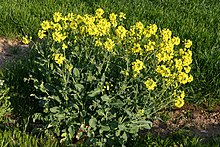Nanohana

Nanohana (菜の花) is a Japanese generic name for flowers of the Brassicaceae family. The related term, nabana (菜花, 'vegetable flower'), refers to the flowers and leaf stalks of turnip, napa cabbage, cabbage, brown mustard, zha cai, and broccoli, belonging to the Brassicaceae family, commonly used in Japanese cuisine.[1] A type of nabana, the rapeseed plant (Brassica napus),[2] is used to produce rapeseed oil (nataneyu). Nabana is also used for decoration.[1]
In cuisine
| Nabana | |
|---|---|
 Ohitashi (boiled rapeseed blossom) | |
| Species | Brassica napus |
The florets, stems, and leaves are all edible, and are commonly boiled and served with dashi (stock) and katsuobushi (bonito flakes).[3] The shoots may also be pickled or served as a salad with mustard.[4]
In culture
A festival celebrating the spring bloom of nanohana, called Nanohana Matsuri, is held annually in Japan.[5]
References
- ^ a b "菜の花と食用にするなばな(菜花)の違いについて教えてください。:農林水産省". Ministry of Agriculture, Forestry and Fisheries. Retrieved 2023-01-05.
- ^ Donald C. Wood (October 2012). Ogata-Mura: Sowing Dissent and Reclaiming Identity in a Japanese Farming Village. Berghahn Books. p. 124. ISBN 978-0-85745-524-6.
- ^ Itoh, Makiko (2013-02-22). "Ready for spring's fresh bounty". The Japan Times Online. ISSN 0447-5763. Retrieved 2020-01-19.
- ^ Richard Hosking (24 February 2015). A Dictionary of Japanese Food: Ingredients & Culture. Tuttle Publishing. pp. 94–. ISBN 978-1-4629-0343-6.
- ^ Michael C. Brannigan (27 August 2015). Japan's March 2011 Disaster and Moral Grit: Our Inescapable In-between. Lexington Books. pp. 95–6. ISBN 978-0-7391-9669-4.
